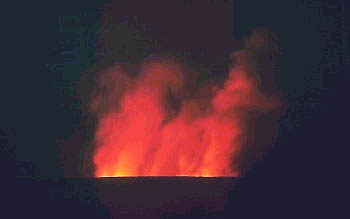
The starting phase of the 1984 eruption of Mauna Loa Volcano,
Hawai'i. The incandescent glow from lava fountains and flows in the summit caldera of
Mauna Loa Volcano is reflected on a cloud of steam and volcanic gas rising from a series
of erupting fissures. This view is from the Hawaiian
Volcano Observatory about 30 km from the summit of Mauna Loa.
USGS photo by J.D. Griggs at 2:30 a.m. HST on March 25, 1984.
Return to Archive or go to Next Photo.
The 1984 Eruption of Mauna Loa Volcano,
Hawai’i – Lessons for the Future
Abstract for Cities on Volcanoes III
Meeting in Hilo, Hawaii, July 2003
Robert W. Decker, lavadecker@aol.com
John P. Lockwood, geohaz@aloha.net
The 1984 summit and flank eruption
of Mauna Loa Volcano was preceded by a small summit eruption in 1975. Deformation
measurements near Mauna Loa’s summit indicated slow but persistent inflation between
1975 and 1983. Throughout 1982 and 1983 the number of shallow and intermediate depth
earthquakes increased beneath the summit area. During
the summer of 1983 the Hawaiian Volcano Observatory warned Civil Defense and local
newspapers of the increasing probability of another eruption, and in September published
that forecast in EOS (Transactions of the American Geophysical Union). At 22:55 on March
24, 1984, a shallow earthquake swarm began beneath the summit of Mauna Loa followed by
volcanic tremor at 23:30. Lava began to erupt in the summit caldera at 01:25 on March 25.
Vents quickly migrated down both the upper southwest and northeast rift zones, but the
southwest vents shut down before dawn. By 07:00, lava was fountaining from vents between
3,800 and 3,700 m on the northeast rift, and at 09:10 a new fissure opened between 3,500 and 3,400 m with lava emission of 1-2
million m3 per hour. At 16:41, a new fissure, 19 km east of the original summit
outbreak, opened between 2,930 and 2,770 m, curtailing the emissions at higher vents. By
March 29, the main flow from these 2,900 m vents had advanced 25 km and was only 6 km from
the outskirts of Hilo. Measures to divert the flow were considered but not tried.
Fortunately, on March 29, a levee on the lava channel collapsed 13 km upstream from the
flow front, diverting lava into a parallel flow. The eruption slowly waned and was over on
April 15. The volume of basalt flows erupted totaled 220 million m3; these
flows covered 48 km2. Lessons
learned will be discussed.
Keywords:
Mauna Loa, eruption forecasting, lava flow hazards

